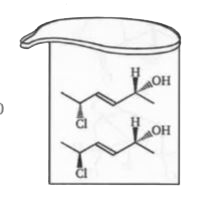The property of glucose to rotate the plane of polarised light is due to the presence of asymmetrical carbon atoms in its structure. This statement is true or false
To determine whether the statement "The property of glucose to rotate the plane of polarised light is due to the presence of asymmetrical carbon atoms in its structure" is true or false, we can follow these steps:
Step 1: Understand the property of glucose
Glucose is a simple sugar (monosaccharide) that has the ability to rotate plane-polarized light. This property is known as optical activity.
Hint: Optical activity is a characteristic of certain molecules that can rotate the plane of polarized light.
Step 2: Identify the structure of glucose
Glucose has a specific molecular structure that includes carbon atoms. In its structure, glucose contains several carbon atoms, some of which are asymmetrical.
Hint: Look for the definition of asymmetrical or chiral carbon atoms in organic chemistry.
Step 3: Define asymmetrical (chiral) carbon atoms
Asymmetrical or chiral carbon atoms are carbon atoms that are bonded to four different groups. The presence of these chiral centers in a molecule contributes to its ability to rotate polarized light.
Hint: Remember that the presence of chiral centers leads to the existence of enantiomers, which are molecules that are mirror images of each other.
Step 4: Relate chiral carbons to optical activity
The rotation of plane-polarized light by glucose is indeed due to the presence of these chiral carbon atoms. Each chiral center can lead to different spatial arrangements of the molecule, resulting in different optical activities.
Hint: Consider how the arrangement of atoms around a chiral carbon affects the overall properties of the molecule.
Step 5: Conclude the statement
Since the ability of glucose to rotate plane-polarized light is directly linked to the presence of asymmetrical (chiral) carbon atoms in its structure, the statement is true.
Final Answer: The statement is true.
Glucose is a simple sugar (monosaccharide) that has the ability to rotate plane-polarized light. This property is known as optical activity.
Glucose has a specific molecular structure that includes carbon atoms. In its structure, glucose contains several carbon atoms, some of which are asymmetrical.
Asymmetrical or chiral carbon atoms are carbon atoms that are bonded to four different groups. The presence of these chiral centers in a molecule contributes to its ability to rotate polarized light.
The rotation of plane-polarized light by glucose is indeed due to the presence of these chiral carbon atoms. Each chiral center can lead to different spatial arrangements of the molecule, resulting in different optical activities.
Since the ability of glucose to rotate plane-polarized light is directly linked to the presence of asymmetrical (chiral) carbon atoms in its structure, the statement is true.
Topper's Solved these Questions
- BIOMOLECULESBOOK - ICSECHAPTER - BIOMOLECULESEXERCISE - TEST YOUR PROGRESS (MATCH THE ITEMS OF COLUMN A WITH THE ALTERNATIVE GIVEN.)
2 Videos
- BIOMOLECULESBOOK - ICSECHAPTER - BIOMOLECULESEXERCISE - TEST YOUR PROGRESS (VERY SHORT ANSWER TYPE QUESTIONS)
77 Videos
- BIOMOLECULESBOOK - ICSECHAPTER - BIOMOLECULESEXERCISE - TEST YOUR PROGRESS (FILL IN THE BLANKS WITH APPROPRIATE WORDS.)
59 Videos
- BIOLOGY ISC SAMPLE QUESTION PAPER 2019BOOK - ICSECHAPTER - BIOLOGY ISC SAMPLE QUESTION PAPER 2019EXERCISE - PART-II (SECTION -C)
6 Videos
- BODY FLUIDS AND CIRCULATIONBOOK - ICSECHAPTER - BODY FLUIDS AND CIRCULATIONEXERCISE - DIFFRENTIATE BETWEEN
13 Videos
Similar Questions
Knowledge Check
Which of the following will give enantiomeric pair on reaction with water due to presence of asymeteric carbon atom?
AC2H5−C2H5∣C∣C2H5−BrBC2H5−C2H5∣C∣CH3−ClCC2H5−H∣C∣CH3−IDCH3−CH3∣C∣C2H5−BrWhich mixture of structure in each beaker would rotate plane polarized light ?
A B
B C
C DAll of these
DAll of these
How do you explain the presence of all the six carbon atoms in glucose in a straight chain?
View SolutionHow do you explain the presence of all the six carbon atoms in glucose in a straight chain?
View SolutionIdentify the monosaccharide containing only one asymmetric carbon atom in its molecule.
View SolutionState true or false :
Silicones repel water due to: The presence of alkyl group pointed towards surface
View SolutionIf all the particles of a system lie in y-z plane, the x-coordinate of the centre of mass will be zero. Is this statement true or false?
View SolutionWrite the name and structure of an alcohol with three carbon atoms in its molecule.
View Solution
